How to Stencil Painted Furniture
This step-by-step furniture makeover tutorial is packed with stenciling tips and tricks so you know how to stencil painted furniture. It’s a super easy and cheap way to make a statement piece of furniture!
Get more painting techniques for furniture here!
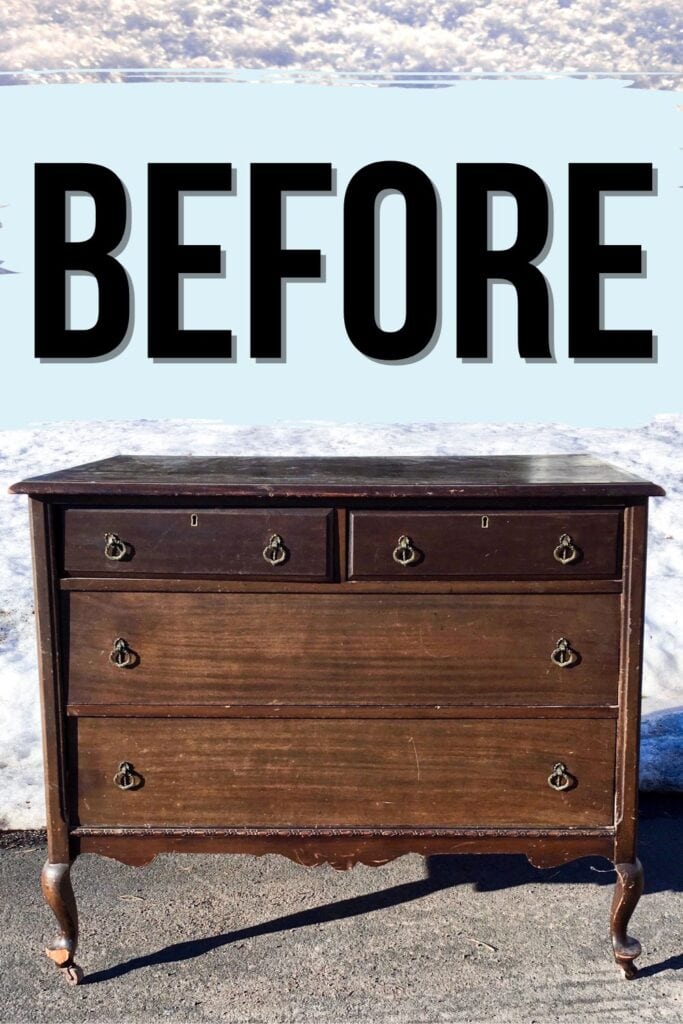
I am super excited to share this stenciled dresser with you today!
This particular dresser started out really sad. The drawers weren’t working very well, the little feet were broken off, and the old finish was wearing off.
Supplies Used to Stencil Painted Furniture
As an Amazon Associate, I earn from qualifying purchases. I also may earn from other qualifying purchases with other companies or get free product to review and use. All opinions are my own.
- Krud Kutter
- 220 Grit Sandpaper
- Vacuum
- KwikWood
- Little Whale by Fusion Mineral Paint
- Paint Sprayer
- Casement by Fusion Mineral Paint
- Floral Stencil
- Repositionable Adhesive Spray
- Paint Brush
- Waterbased Polyurethane
Repairing Dresser Drawers and Feet
So first things first, I made the necessary repairs needed (fixing the drawers and the feet) before I even thought about painting. The repairs were actually pretty simple!
The drawers just needed a good sanding down on the sides because the wood had swollen in the humidity out in the garage. We saw this a lot with furniture when we lived in Minnesota.
I just kept sanding until the drawers easily fit back and forth in the dresser.
Then I added wax to the bottom of the drawers where they slide, and to the railing that the drawers slide on. The wax just gives the drawers some slip to make them open and close easier. Yay!
If you’re having issues with the runners, here’s how to repair worn drawer runners.
More tips for old dresser drawers that won’t slide here.

At first, I thought I wanted to replace the little flare on the feet by replicating the leg that was still intact and then adding it to the other leg.
I was going repair it with this trick here in this post on how to repair broken trim on furniture! But then I noticed that the flares on the legs were separate pieces that were probably just glued onto the legs.
It looked like a quick and easy fix to knock them off with a hammer and then sand the legs down into a smooth rounded shape. So that’s exactly what I did!
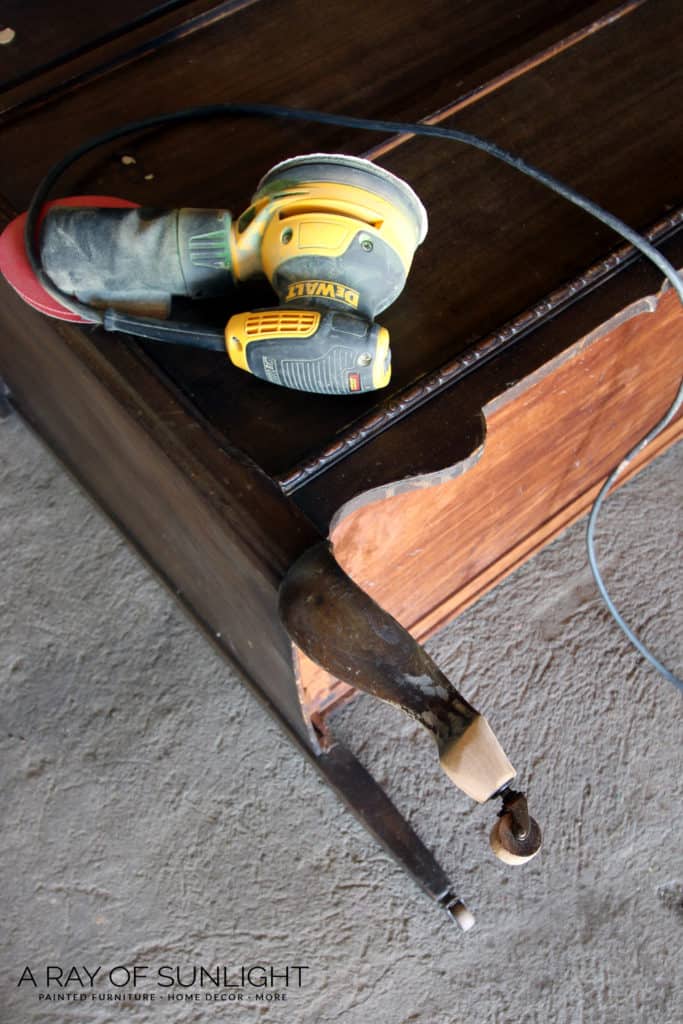
Just as I suspected, the little pieces of the flare came off easily with a few taps of the hammer.
Prepping Dresser for Paint and Stencil
Once the repairs were done, it was time to prep the surface of the dresser for paint. This part is the very most important part of any furniture makeover. Dead serious. But it’s super easy! I promise!
If you don’t prep your furniture you can have multiple problems show up before you even finish painting, or a few days after you completely finish painting.
Prepping should only take about 30 minutes or so on a piece like this, but it can save you hours of work if you end up with peeling paint or bleed-through issues.
Some paint companies claim that you don’t need to prep at all. This is sooo false it’s not even funny.
Yes, their paint can stick to a lot of surfaces, but not all surfaces. And if you are going to be setting things on that surface or using it at all on a daily basis, your paint is just not going to hold up.
The paint needs something to hold onto. If the finish of the furniture is shiny, smooth and/or glossy, you REALLY NEED TO PREP.
I can almost guarantee that your paint will scratch off very easily, or it may even peel off if you don’t prep. Yikes!
Think of how hard it is to hold onto something that is super slick, versus how easy it is to hold onto something that has grip to it.
(Maybe your phone with a slick case, vs your phone with a grippy case). It’s the same way with paint.
The paint just can’t hold onto slick surfaces without some help. We need to make the surface more grippy so the paint can hold on and stay on.
- Clean the surface with a dewaxing, degreasing cleaner. I personally love Krud Kutter for this.
- Scuff sand the surface with 220 grit sandpaper. You don’t need to sand down to the bare wood. Just scuff up the finish so you can see tiny little sanding marks in the old finish. (Read more about the importance of sanding before painting furniture here).
- Vacuum and wipe off the dust with a damp rag (water).
Here’s all about how to prepare furniture for painting!
Filling In Hardware Holes
If you want to change the hardware on the drawers, you’ll want to fill in the old holes and drill new ones.
I filled the holes in the top drawer with my favorite hardware hole filler – KwikWood. It dries super hard, it doesn’t shrink or crack like wood filler, and it dries fast!
Then I drilled new holes in the middle of the top drawers. Learn more about how to change hardware on a dresser here!
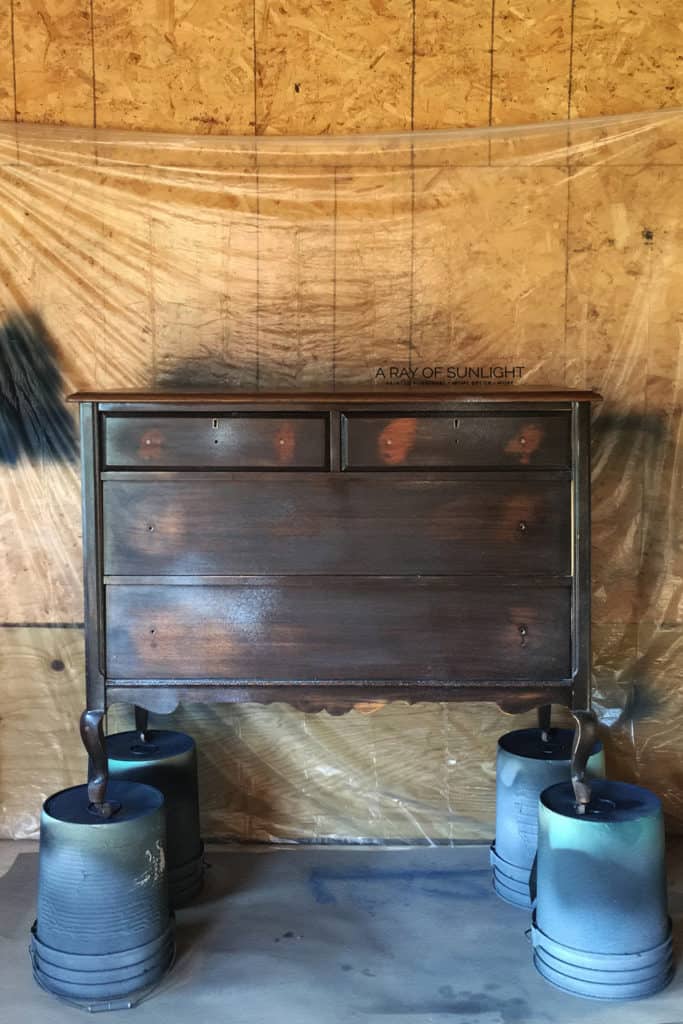
Preventing Bleedthrough
What is bleedthrough?! Bleedthrough is a pain in the rear. It shows up as stains that come through the paint in the form of red, orange, or yellow spots.
Sometimes they are all over, and other times they show up in just a few spots. No matter how many times you paint over them, they continue to return once the paint is dry.
And to make matters worse, sometimes you can’t see them at all until you seal your paint with a water-based poly (my favorite and the most durable way to seal your chalk-painted furniture).
So you’ll literally be completely done with your piece, just to start seeing ugly spots all over your furniture. Noooo!!
So I always work to prevent bleedthrough from the beginning. Always. It’s easy to prevent it when you use the right products and give them some time to work.
Learn the best ways to prevent bleedthrough and stop stains from coming through paint here.
Painting Dresser Light Blue
With all the repairs and prep done, it’s finally time to paint! Yay!! For the base color of this dresser, I used Little Whale by Fusion Mineral Paint. It’s a soft light blue color that is just perfect.
((IF you want to shop small and support a family business, you can find Fusion Mineral Paint here at Lost and Found Decor’s shop.))
I painted a couple of coats of Little Whale, and once the second coat was dry to the touch I distressed the edges of the dresser with 220-grit sandpaper.
Read more about the 6 best distressing furniture techniques in this post!
The coverage of this paint is amazing! A light color over a dark color should need multiple coats for the best coverage. All that was needed was 2 coats of paint!
Check out more light blue painted furniture here.
**After the first coat, I still had some bleedthrough coming through and some dings and scratches to repair that I couldn’t see before the paint. So I took a step back and addressed those issues before moving on.
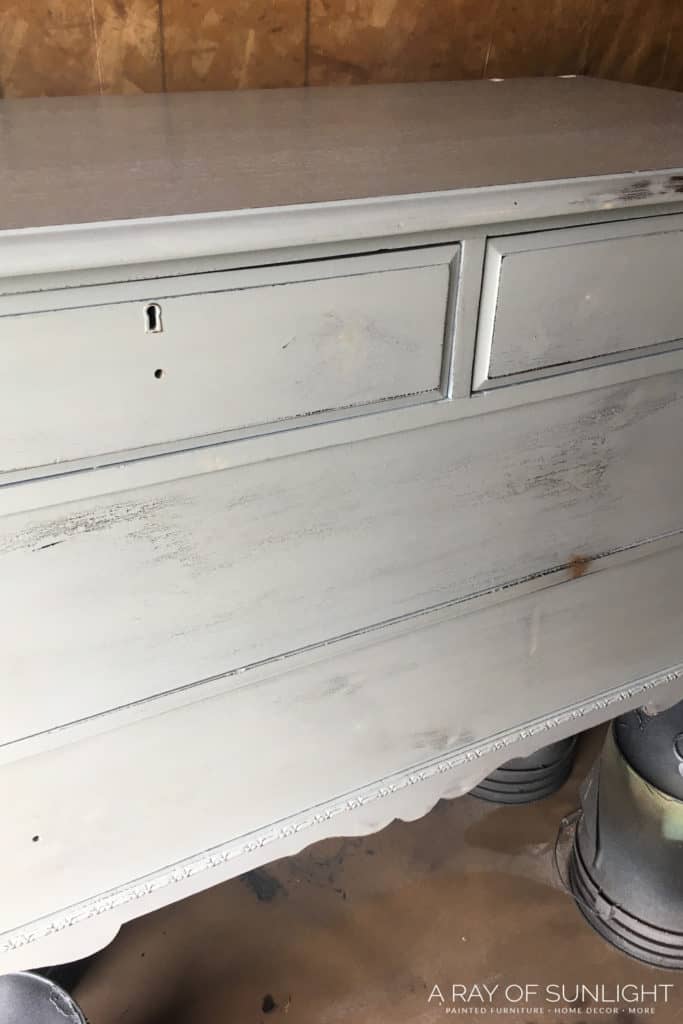
Fusion Mineral Paint Review
This was actually my very first time using Fusion Mineral Paint. And to be very honest, I was very skeptical of their “built-in topcoat”.
They say that you don’t need to prime and that the paint is durable – no need for a topcoat. With chalk paint (my go-to paint), you have to topcoat it or else it’s super porous, and it’s not as durable.
So this no topcoat required thing really sounded amazing! But I was blown away when I tested a couple of coats on a drawer front.
A few days later I wanted to get some photos for a blog post about scratching off paint, so I went out to that drawer and used my car keys to scratch off the paint.
I couldn’t get the paint to scratch off until I put a lot of force into the scratching! That was only after a couple of days of the paint drying!
Cure time (when it’s at it’s best) is 21 days! So I was blown away after only a couple of days! The gray scratches below are where I was scratching normally with my keys.
Since the paint wasn’t coming off, I started to dig and scratch really hard with the sharpest of all keys. That’s the only time I could get the paint to come off in small areas.
Now, no one in their right mind (except for kids haha) are going to be digging into this paint with all their strength. So this was a huge deal for me to see how tough this paint is!
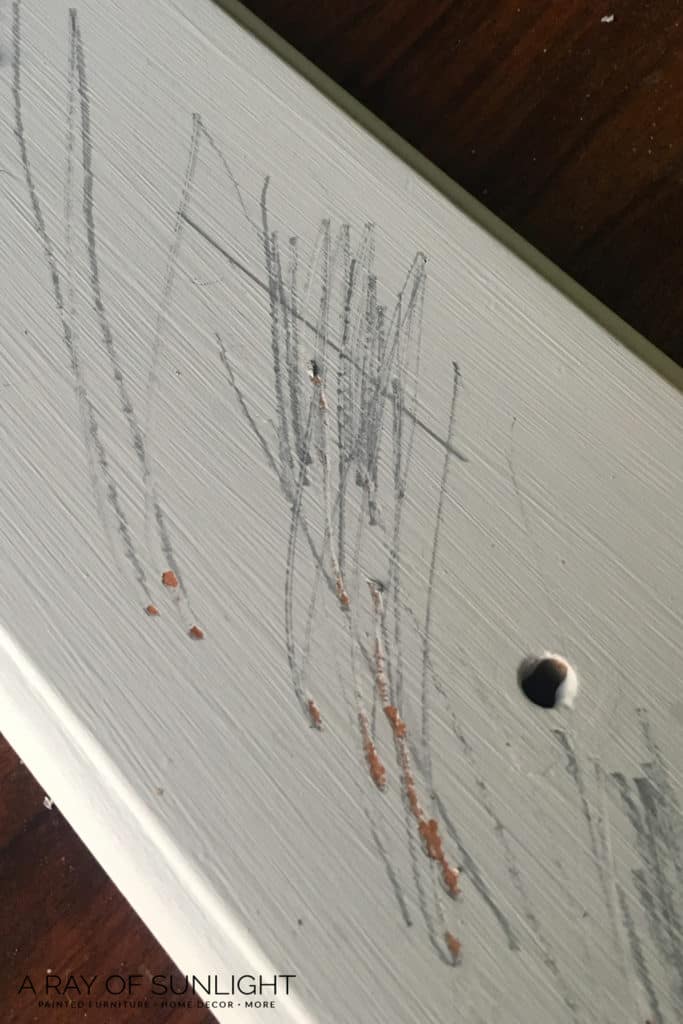
Check out this list of the best paints for furniture to see how they compare.
Spraying Fusion Mineral Paint
My favorite method of painting furniture is to spray the paint on with my paint sprayer.
Of course, you can always brush the paint on too if you don’t have a sprayer, but I just love the brush-free finish, and how fast spraying goes!
Note: I have played around with Fusion Mineral Paint and a couple of paintbrushes. Honestly, the very best finish with a paint brush was with the Staalmeester brush! It’s a little bit more pricey, but it’s such a good brush!! It’s heavenly actually!
Read this post to learn more about the best paint brushes for painting furniture if you decide to brush the paint on.
Spraying Fusion Mineral Paint was super easy. It sprayed like a dream and it dried sooo smooth!
I did thin the paint out with some water for my paint sprayer (more about how to thin paint for a paint sprayer here). Since the paint is thinner than chalk paint, I didn’t have to add too much water.
The best way to make sure the paint is the right consistency for the sprayer is to spray it on a piece of paper or cardboard before painting your furniture.
You want to make sure it’s the right consistency BEFORE spraying your furniture so you don’t end up with drips and runs or a very textured and splattered finish.
Having a nicer paint sprayer really helps, but you can definitely get a high-quality finish with the Wagner Double Duty sprayer, this hobby sprayer that I used for years before upgrading to a better sprayer like the Fuji Q4 paint sprayer.
Creating the Stenciled Dresser
For the white flowers, I used Casement by Fusion Mineral Paint and a little set of floral stencils. I won’t lie. I was a bit nervous about stenciling furniture.
I was worried that the paint would bleed, that I wouldn’t get the placement of the flowers right, and that it would just look terrible. So if I can do this, you can do it too!
How to Stencil Painted Furniture
This is the process I used to stencil the front of this dresser with flowers.
I didn’t use a specific furniture stencil. I think this is just a craft stencil, and it’s very small. But I was able to work with each piece of the stencil to make a unique floral pattern all over the front of the dresser.
- Cut around each flower stencil so they are easy to work with and small.
- Decide where you want to start (I started in the corners) and which direction you want each stencil to go.
- Lightly spray the adhesive on the back of the stencil and let it sit for 1 minute to get tacky.
- Stick the stencil in place and make sure it’s all sticking to the furniture.
- Dab the paintbrush into the paint. Make sure to only get a very small amount of paint onto the brush. Dab off the excess onto a paper towel. If there is too much paint, your paint will bleed under the stencil and you won’t be able to see the tiny lines in each flower. Less is more!
- Lightly pounce the paint onto the stencil. DO NOT brush it on from side to side. Brushing it on can also make the paint bleed under the stencil.
- Get more paint as needed.
- Peel the stencil away to reveal your floral design!
- Repeat this process, filling the front of the dresser with stenciled flowers!
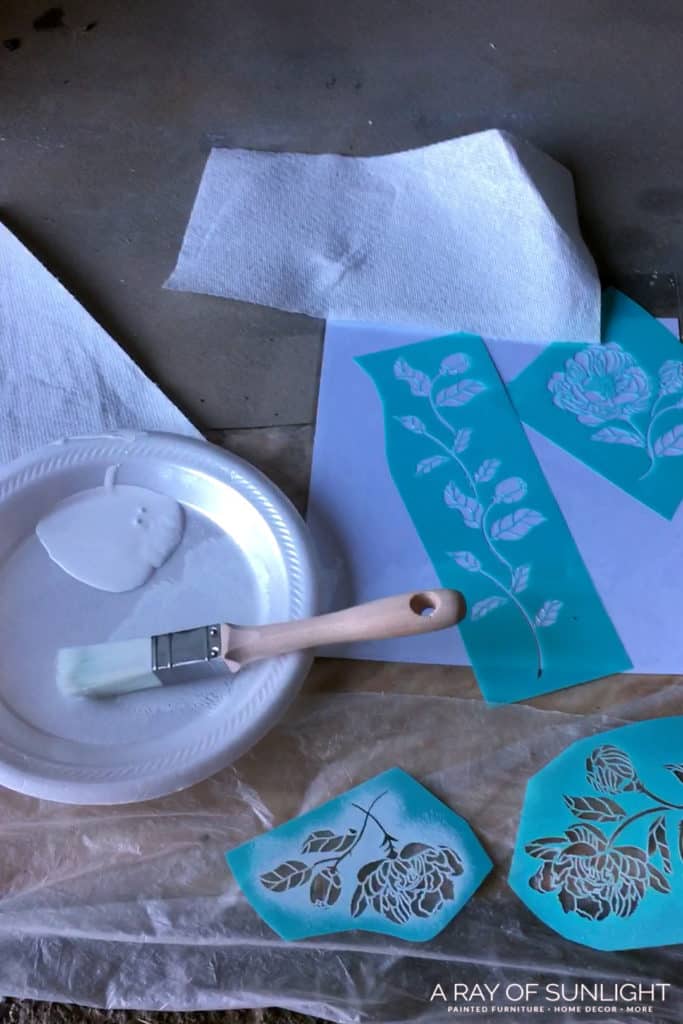

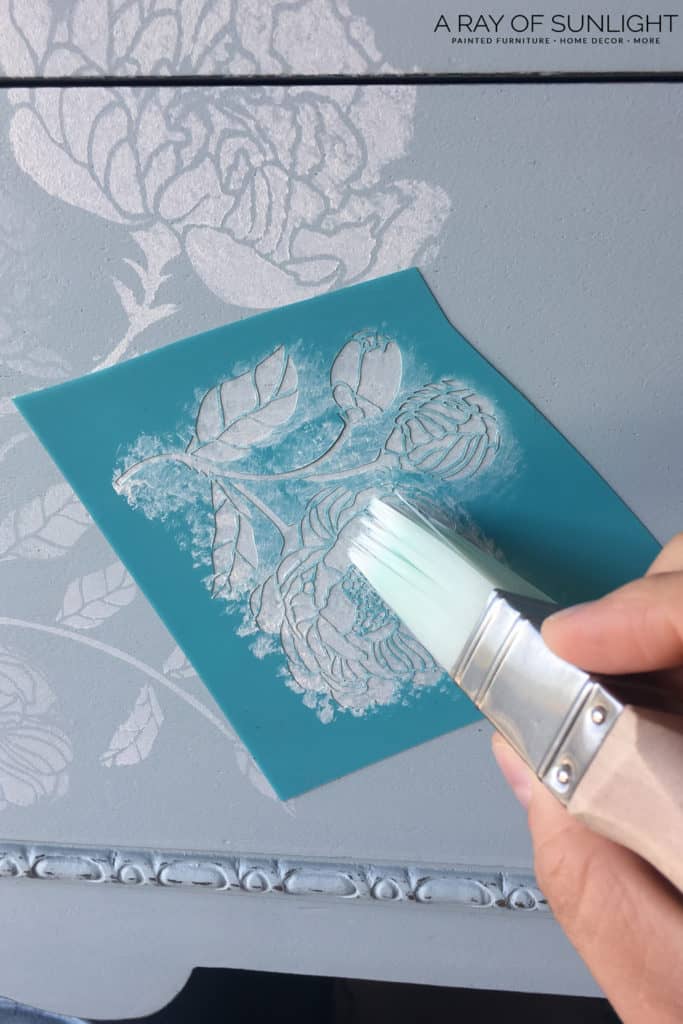

Stenciling Tips
Here are more stenciling furniture tips and tricks for beautiful results on your painted furniture!
Hold Stencil in Place with Repositionable Spray Adhesive
The adhesive is a game-changer with stenciling. And it doesn’t leave any residue on the dresser when you pull off the stencil.
You could just tape the stencil in place, but the tape won’t be able to hold all of the tiny parts of the stencil in place.
The adhesive makes it less likely for the paint to bleed under the stencil. If the paint gets under the stencil, your flower will just look like a blob of paint. Not pretty.
Learn more about how to stencil without bleeding here.
A little bit goes a long way. Just lightly spray the back and let it dry for about 1 minute to make it perfectly tacky.
The tack is only good for one time. You’ll need to spray the stencil again before placing it on the dresser again.
Paint for Stenciling
A little bit goes a long way. Seriously. Make sure there is only a small amount of paint on your brush. If there is too much paint, the paint can get under your stencil and make it look messy.
You can always get more paint onto the paintbrush once you run out of paint, but you can’t easily remove a blob of paint from your already painted dresser.
The Best Paint Brush for Stenciling
Technically you should use a stencil brush. They are round and flat at the tip. I didn’t have any stencil brushes on hand, but I found a paintbrush that had a flat tip and it worked perfectly!
A small paintbrush is also better than a large brush when you’re working with a small stencil. It helps keep the paint in the stencil and to get the paint into the details.
How to Place Stencils on a Dresser
I started in the corners of the dresser and worked my way into the middle.
Actually, I had a different plan for the stencil design than what it ended up as. But that’s okay! I love how it came out anyway!
I placed only one or two stencils at a time so I could make sure to space everything well. I also turned the stencils around a lot to make the flowers go in different directions.
It was the easiest to put the stencils on a flat surface. The top drawers with different levels were hard to work with. So make sure to pick a dresser with very few details.
These drawers weren’t perfect by any means. They sit at a slight angle because of wear and tear over the years.
So I pulled the drawers out where everything was flush in the area I was working in right then.
Finishing Dresser After Stenciling
Once the stenciling was done I lightly sanded the front down by hand with 400-grit sandpaper. The sandpaper made the stenciled flowers nice and smooth.
Since I distressed and sanded the paint I finished it off with a coat of matte water-based poly.
Learn ALL of my tips and tricks on how to spray polyurethane here! And learn more about different topcoats for painting furniture options here.
I switched out the old hardware for new white knobs that are just so adorable!
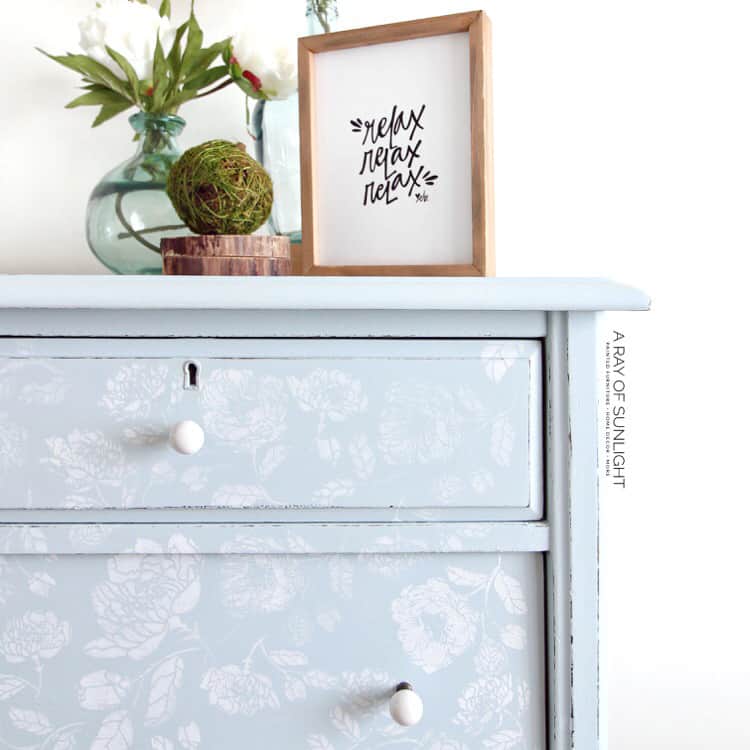
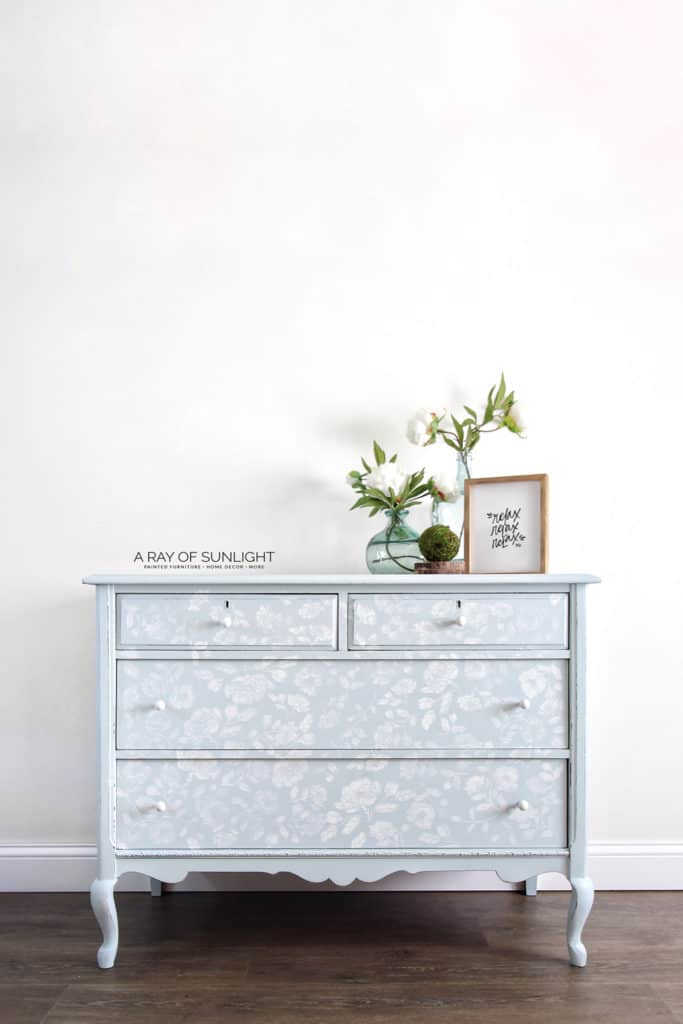
More Before And After Makeovers
Click any of these “before” photos below to view the “after” of that makeover.
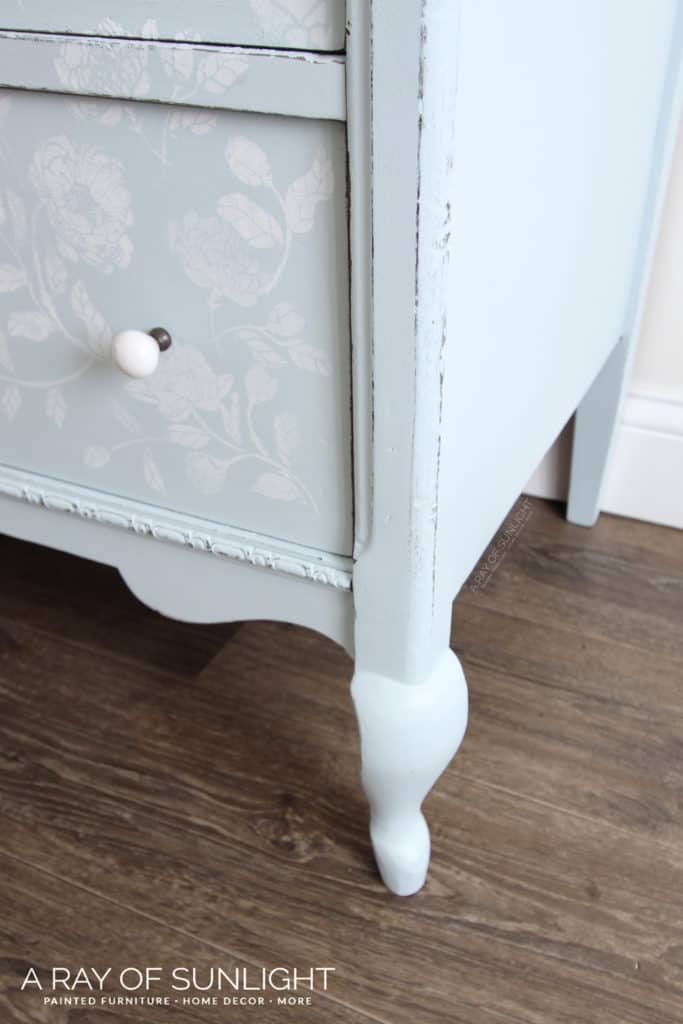

I hope you’ll create a stenciled dresser with these tips! Let me know what you think in the comments below!
Get more shabby chic painted furniture inspiration for your next painting project here.
More Stenciling Furniture Resources
Follow us on YouTube to get more tips for painting furniture.
Or share your project with us on our Facebook Group and be part of our community. See you there!
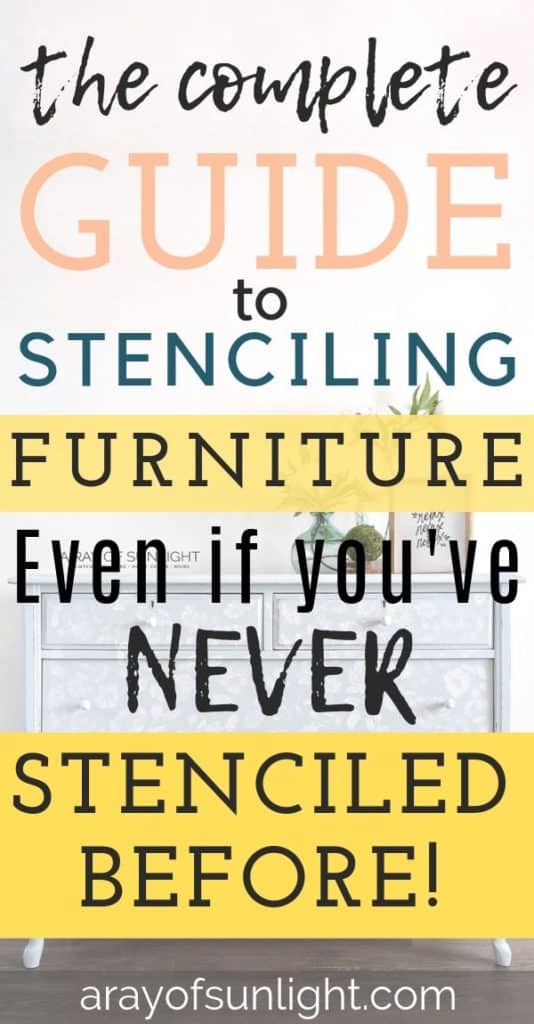

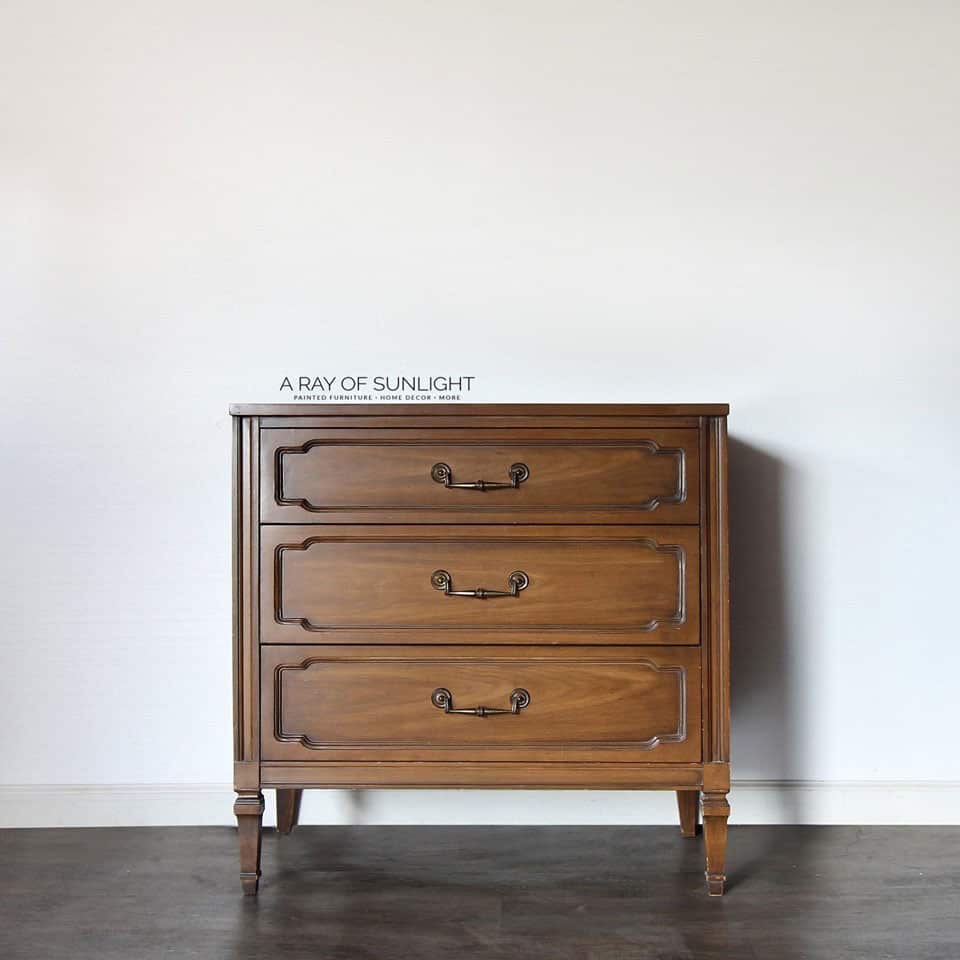






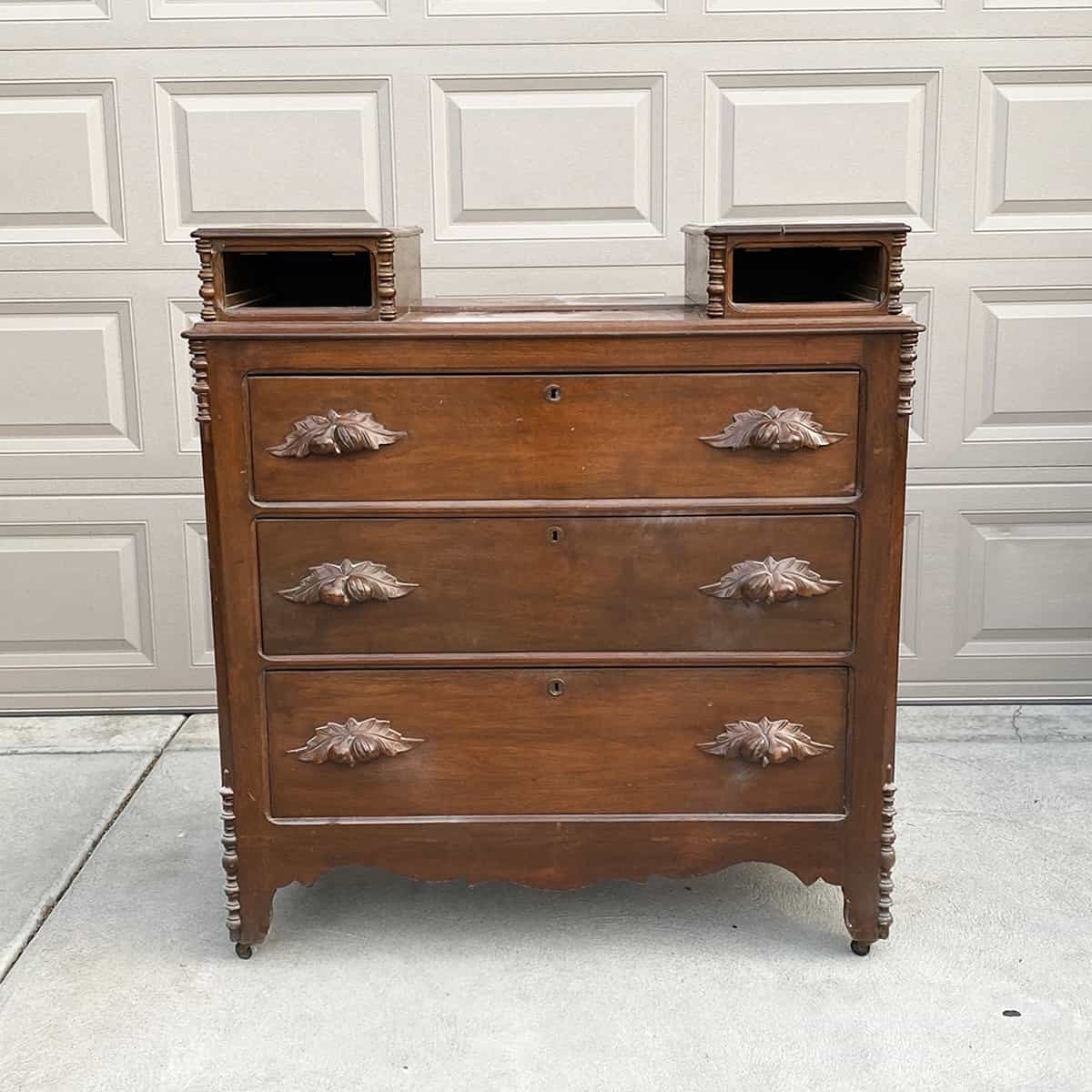
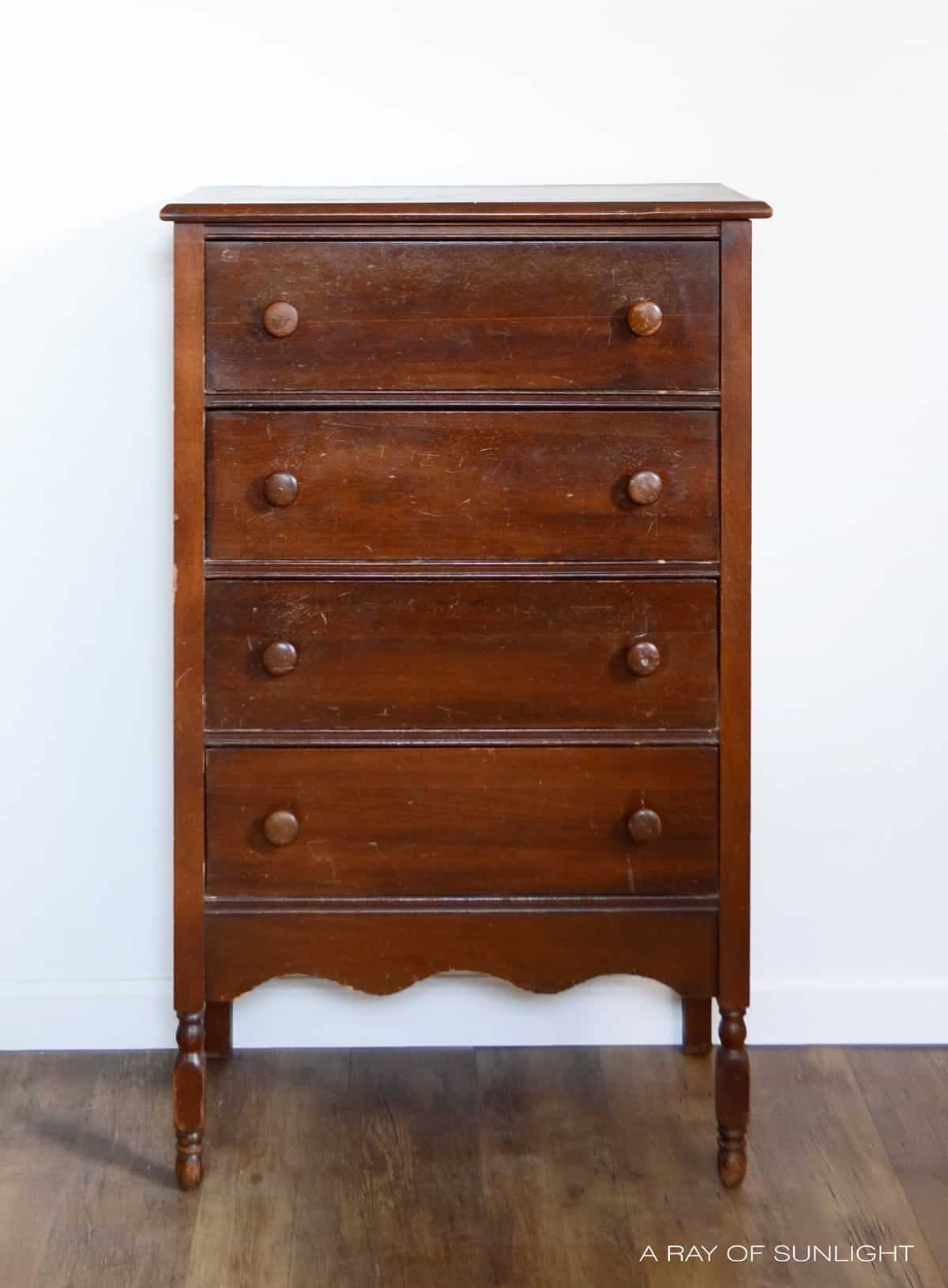
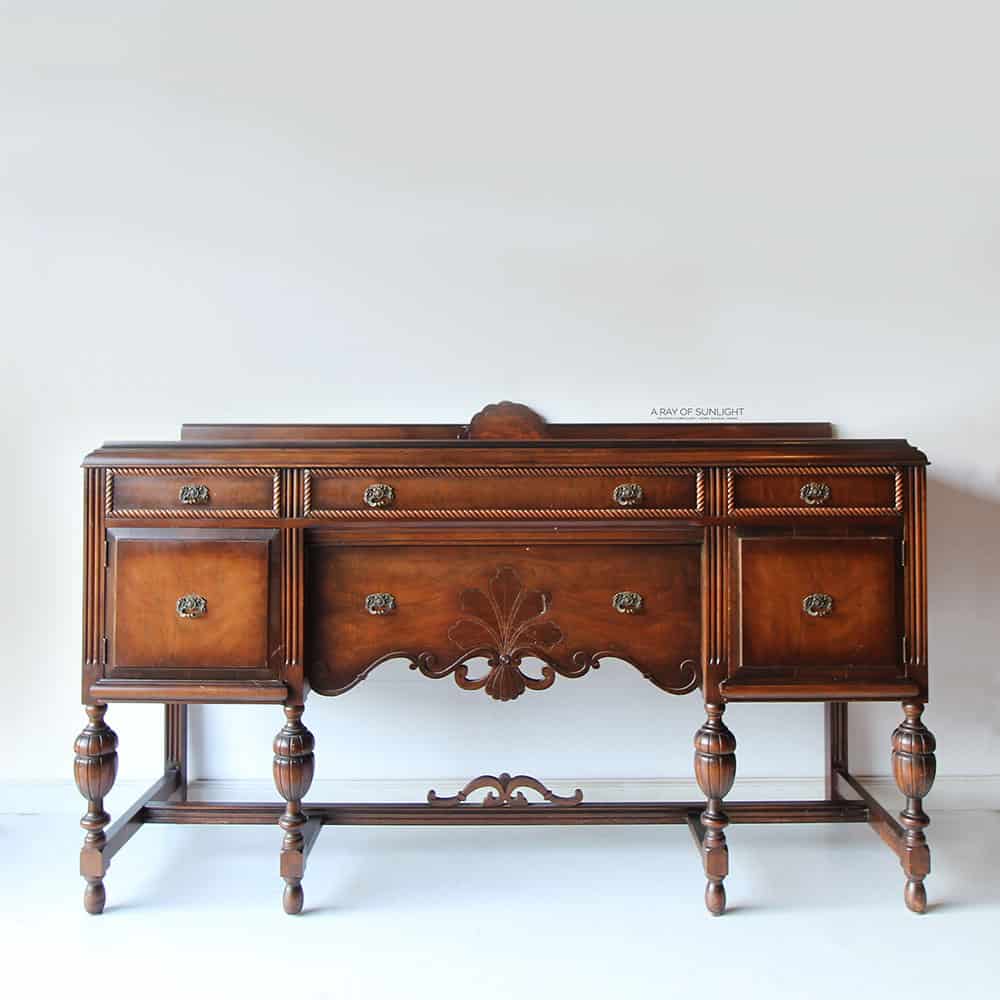

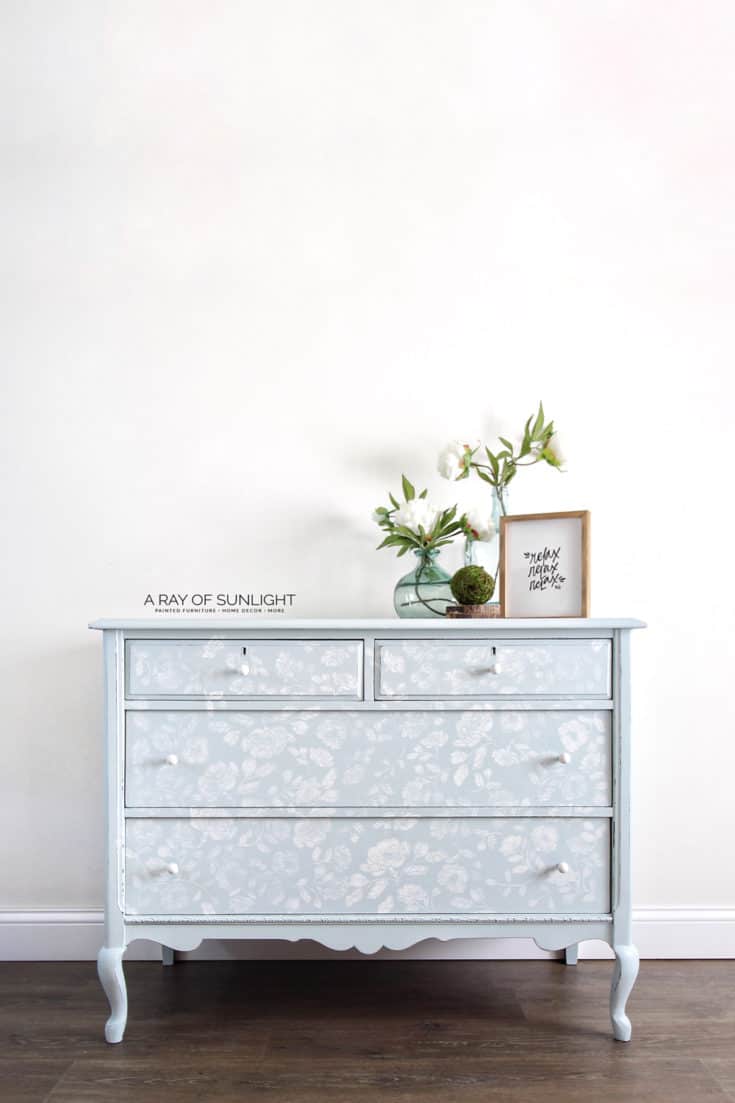




What a great transformation! Your blogs are always so inspiring and educational!! Those stencils really pretty!
Thank you so much Jess! I really appreciate it!
So informative! I think I need to try a stencil now, and when I do this will be my first stop for instructions. Amazing, as always, my friend!
Thank you so much Keegan! You are so sweet! I hope you try stenciling sometime!
This totally makes me want to stencil something now!
You totally should stencil a dresser Lauren! Even if it’s two light colors. I think it would be fun!
Gorgeous Natalie!! The stencil is so beautiful – I love the white over the blue!
Thank you so much Cait! I really appreciate it!
The stencil work on this piece is spectacular! I have to try this!
Thank you so much Amy! You definitely should try it!
Natalie,I love your blog!! You are so creative. Thank you for all the inspiration . It’s also good to know how to start a piece from the beginning . Thank you
You are so sweet Cheryl! Thank you so much!
so much fun!! inspiring me for my first attempt!
How long do you wait after the base coat paint before you stencil? I don’t want to mess up the new paint by sticking a stencil on to it. And what type of paint do you use for the stenciling?
It depends on the paint that I use. To be safe, wait 24 hours. You can use almost any type of paint for the stenciling.